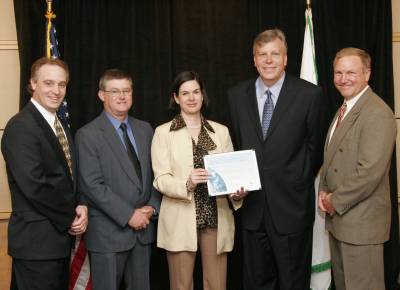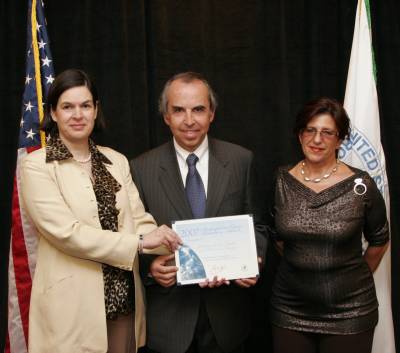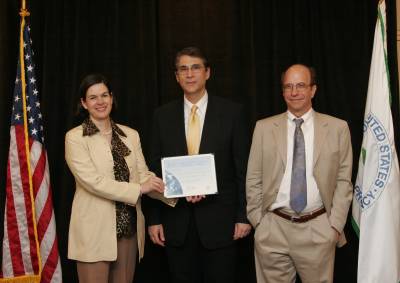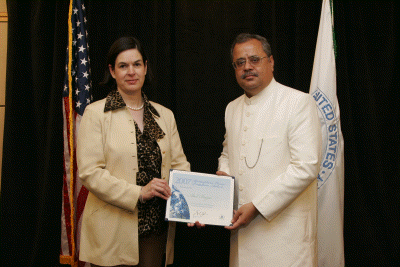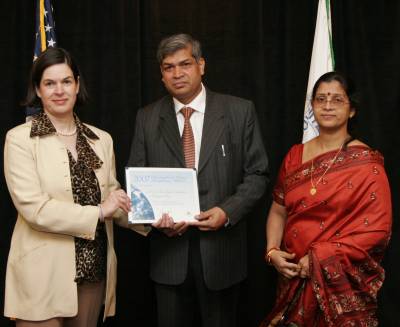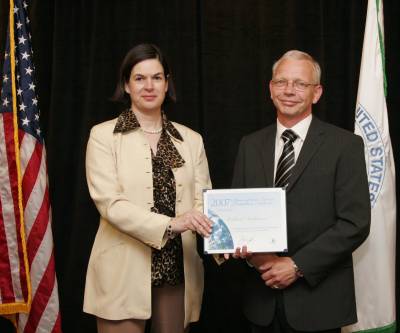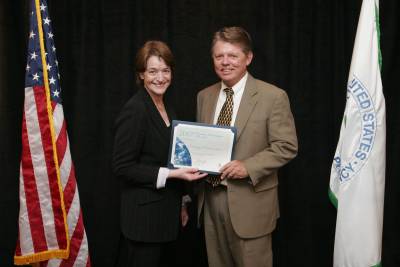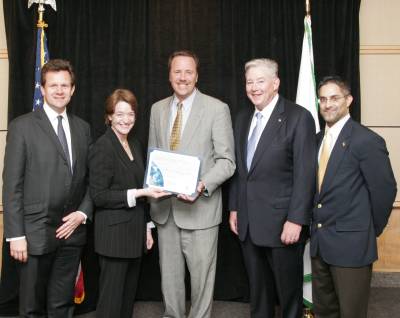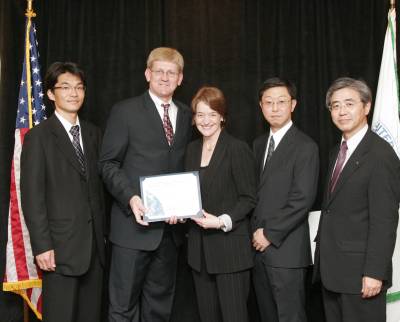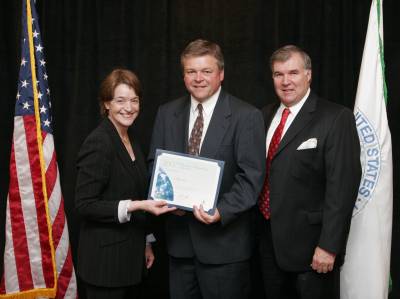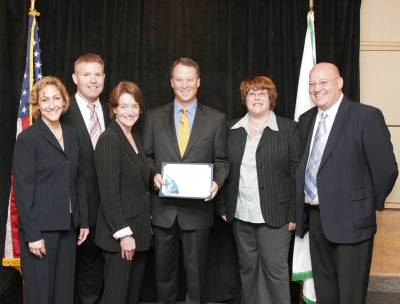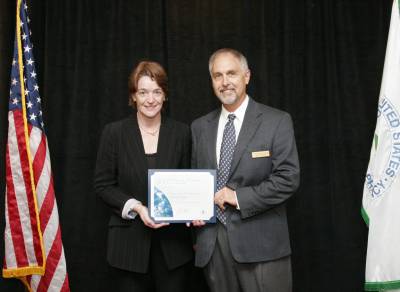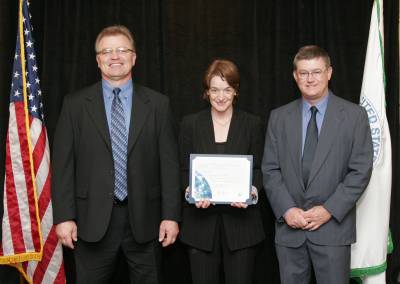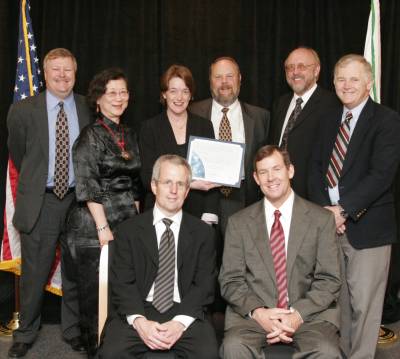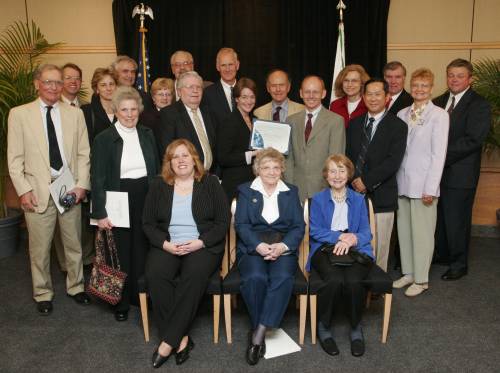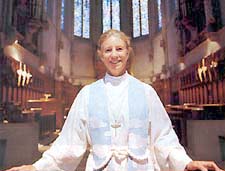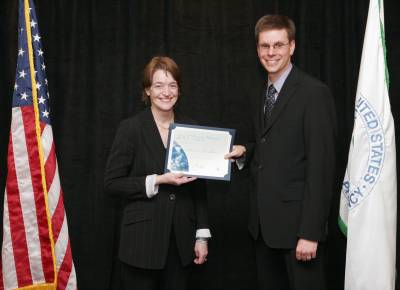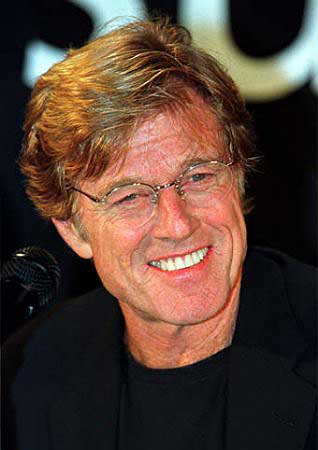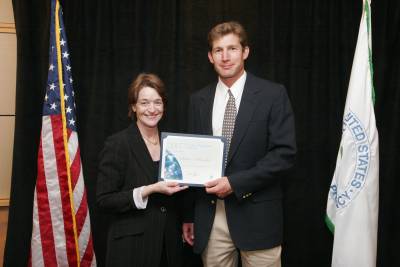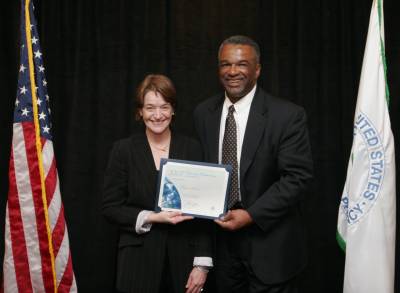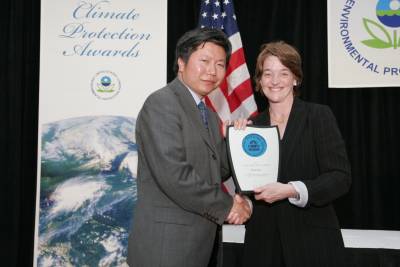EPA Honors Climate and Ozone Protection Award Winners(Washington, D.C. - May 1, 2007) World
customs inspectors, skin cancer prevention experts, an international bank, and a
reverend are among the 31 individuals, organizations and companies from around
the world that EPA will recognize today for outstanding efforts to protect the
Earth's climate and stratospheric ozone layer. The award recipients have
demonstrated ingenuity, leadership and public purpose by improving their
environmental performance and encouraging others to do the same.
The awards were presented at a ceremony this afternoon at the International
Trade Center in Washington, D.C. Since the annual Stratospheric Ozone Protection
Awards began in 1990, EPA has honored 510 individuals and organizations from 42
different countries. EPA began the Climate Protection Awards in 1998 and has so
far recognized 139 individuals and organizations from 16 countries for
outstanding efforts to curb climate change.
2007 Stratospheric Ozone Protection AwardsCORPORATE AWARDS
Eclipse Aviation Corporation Eclipse Aviation embraced significant business, technical, and financial risk to develop and certify a new non-ozone depleting fire suppression technology for aircraft engine nacelles. This innovative material and dispersal technology, PhostrEx™, is the first plausible alternative in this application to Halon 1301, a fire suppressant that was phased out under the Montreal Protocol on Substances that Deplete the Ozone Layer. PhostrEx™ fire suppression systems occupy one tenth the space, have one tenth the mass, and have less than one tenth the life cycle cost of the Halon systems that they are destined to replace. The development and certification of a Halon alternative for aircraft fire suppression is a major milestone in the effort to eliminate ozone depleting compounds from the aviation industry. The discovery of PhostrEx™ will allow replacement of Halon1301 for certain aviation fire suppression applications without compromises to system weight, volume, and performance and will protect stratospheric ozone, and may lead to wider non-aviation applications in the future.
SPX Corporation The SPX Robinair next-generation refrigerant recovery and recycling machines are the first to meet the Society of Automotive Engineers (SAE) standard J-2788, which requires that equipment to recover 95% of the refrigerant and recharge to within 1/2 ounce. Previously, refrigerant recovery machines left behind as much as 30% of the refrigerant which would then escape to the atmosphere. SPX was an active partner in the Mobile Air Conditioning Climate Protection Partnership founded by SAE, the US EPA, and the Mobile Air Conditioning Society Worldwide to reduce emissions of R-12 and R-134a from motor vehicle air conditioners. By providing facilities, equipment and technical expertise, SPX Robinair helped the Improved Mobile Air Conditioning (I-MAC) partnership improve the efficiency of mobile air conditioners by 30% while simultaneously reducing refrigerant emissions by 50%. As a result of this program, the SAE recently approved tighter standards for automotive A/C recovery, recycle and recharge equipment, including the new J-2788 standard, which will usher in a new generation of atmospheric protection. ORGANIZATION, ASSOCIATION & TEAM AWARDS
Food and Drug Administration
(FDA) Essential Use MDI Team The FDA Essential Use Team has demonstrated exemplary leadership and inter-Agency cooperation in phasing out class I ozone depleting substances (ODS) in essential use metered dose inhalers (MDIs). As established under the Clean Air Act, FDA works in cooperation with EPA’s Stratospheric Protection Division in an annual rulemaking to allocate essential use allowances for the manufacture of MDIs. Dr. Chowdhury, Dr. Meyer, Mr. Mitchell, and Dr. Sullivan have provided vital medical and legal expertise to the rulemaking process and have largely contributed to the success of the essential use program, which is in its final years. As of December 31, 2008, CFC-albuterol MDI will be phased out in the United States and the MDI essential use program will largely be completed. Furthermore, Dr. Chowdhury, Dr. Meyer, Mr. Mitchell, and Dr. Sullivan have worked effectively with the MDI manufacturers and patient advocacy groups over many years to ensure a smooth transition to CFC-free MDIs. Most recently, Dr. Chowdhury was a member of the US delegation to the 18th Meeting of the Parties where his contributions were essential to the success of the negotiations. Team Members:
Jardines de los Andes and
Flores de Funza The Colombian flower industry, the second largest world flower exporter since the early 1990s, does not rely on methyl bromide. With nearly 7000 Ha in production providing nearly 80,000 jobs and exports valued at over USD $700 million last year, Colombian flower growers have learned to manage soil pests and diseases without methyl bromide mainly through an Integrated Pest Management approach. Since 1996, the Colombian Association of Flower Exporters ASOCOLFLORES launched FLORVERDE®, a social and environmental program designed to help growers produce flowers within a strict framework of sustainability, worker welfare and environment friendly practices. A team of experts supervises compliance with the detailed Code of Conduct, which prohibits methyl bromide use, and an auditing company certifies participating farms. Jardines de los Andes and Flores Funza deserve special mention for their constant support to UNIDO projects, their generosity in sharing pest management strategies, and the outstanding level of sustainability achieved in their flower farms. They have made time unconditionally for growers from Guatemala, the Dominican Republic, Kenya, Turkey, Mexico, Argentina, and other countries. They have provided ample information on costs and results of alternatives, how to solve problems that could arise and how to adapt these technologies to specific circumstances.
National Oceanic and
Atmospheric Administration (NOAA) Ozone-Depleting Gas Measurement Team Stephen Montzka, Geoff Dutton, Bradley Hall, James Butler, and James Elkins have been reliably and consistently monitoring the presence of halocarbons and other trace gases in the atmosphere for more than a decade. They also have tracked the presence of and removal of ozone-depleting substances in the atmosphere, in the oceans, and in polar snow. The team reported the first measured declines in ozone depleting substances (ODS) in the troposphere. Their continued observations have found some natural sources and sinks for methyl bromide and a lack of natural sources for other ODS. Geoff Dutton leads the remote instrument measurements of the major CFCs. Brad Hall’s work on preparing and maintaining standard scales and calibrating standards used by field instruments ensures long-term consistency and accuracy of the data, which are relied on by researchers, governments and the international community. Steve Montzka is responsible for the measurements of most other ODSs, such as other CFCs, HCFCs, chlorinated hydrocarbons, CH3Br, and other brominated gases. He takes a lead role in publishing the results along with Jim Butler, who has improved our understanding of the ocean’s role in influencing ODS amounts in the atmosphere and derived 100-year atmospheric histories from air trapped in Antarctic snow. James Elkins has directed this team for over 20 years, providing necessary support for the research. Team Members:
Regional Intelligence Liaison
Office for Asia and the Pacific, World Customs Organization The Regional Intelligence Liaison Office for Asia and the Pacific (RILO A/P) is the focal point of intelligence collection, analysis, dissemination and international law enforcement cooperation among customs administrations in this rapidly-developing region. Working closely with UNEP to combat illegal trade in ozone depleting substances (ODS), they have raised awareness among customs authorities and have facilitated information and intelligence exchange on ozone issues. This led to, for example, a meeting between Cambodia, Laos, Thailand and Vietnam to address illegal trade in a more effective way. RILO A/P analyzed ODS smuggling trends and disseminated information to key customs stakeholders in the region, other RILOs around the world, the World Customs Organization, Interpol and other international enforcement organizations. RILO A/P also coordinated “Project Sky Hole Patching” to combat illegal trade in ODS and dangerous waste in the region. The program monitors the movement of suspicious shipments of ODS across several customs territories, involving customs administrations, environment authorities, UNEP and its Compliance Assistance Programme, OzonAction Programme, Basel Convention Regional Centers and other key international organizations. Twenty customs administrations have joined the project, and more are expected to participate. The project is curbing smuggling of environmentally sensitive commodities and enhancing the cooperation between customs authorities and environmental agencies. Secretariat-General of the
Cooperation Council for the Arab States of the Gulf In December 2005, the Gulf Cooperation Council (GCC) for the Arab States made a giant step forward in ozone protection by enacting Unified Legislation on Ozone-Depleting Substances. This Unified Legislation covers all six GCC member states—Bahrain, Kuwait, Oman, Qatar, Saudi Arabia, and the United Arab Emirates—and strengthens the cooperation and coordination amongst members to monitor and control ODSs. The Unified Legislation is the result of the good work of the GCC Secretariat-General. The Secretariat first coordinated information sharing symposia specific to the Gulf region and then worked in close cooperation with the GCC Ozone Group and the United Nations Environment Program (UNEP) to draft and submit the proposed legislation for discussion amongst National Focal Points. Thereafter the Secretariat convinced the high-ranking representatives of GCC member states to finalize the submitted legislation. Thanks to the Secretariat’s efforts, the proposed Unified Regulations were approved by the Environmental Ministers representing Environmental Authorities of the GCC; then by the Ministers of Foreign Affairs, and ultimately by the leaders of the GCC member states.
Skin Cancer Awareness and
Prevention Team Dr. Allan Halpern and Alan Geller have shown exemplary leadership as co-chairs of the National Council on Skin Cancer Prevention, facilitating skin cancer awareness, prevention, and early detection through education and promotion of sun-safe behaviors. The most common cancer in the United States, with one person dying every hour, skin cancer is nonetheless a largely preventable disease. Under this team’s direction, the Council has advanced a national agenda for prevention through the efforts of its over 30 member organizations under the core leadership of the American Academy of Dermatology, Skin Cancer Foundation, American Cancer Society, and Melanoma Research Foundation Alan Geller utilized his extensive academic and professional contacts to bring in outside organizations with a broad skin cancer prevention focus and background, setting an ambitious agenda. He also has spearheaded research on teen tanning issues. Dr. Halpern serves as the public face of the Council, appearing on numerous TV programs to speak about skin cancer prevention and early detection. He also designed a strategic plan and structure for maintaining the Council, including securing funding from member organizations. Several of Dr. Halpern's patients have contributed funds for specific projects, reflecting the great esteem his individual patients have for him. Team Members:
INDIVIDUAL AWARDS
Omar E. El-Arini When he arrived in Montreal in 1991, to take up his post as the Chief Officer of the Secretariat of the Multilateral Fund, Omar El-Arini had little more than a typewriter, a broad framework that had been negotiated by the Parties and an unyielding commitment to protect the ozone layer. Over the next 12 years, Dr. El-Arini hired and trained a professional staff and with the Fund’s Executive Committee gave life to what was originally nothing more than mere concepts embedded in the Parties’ negotiated text. He personally pioneered the interpretation and application of “eligible incremental costs,” and oversaw the development of a framework that led to the approval of over 4,631 projects in 133 developing countries. He pioneered the shift from a project-by-project approach to the sectorial and national phaseout approach. He oversaw the creation of a transparent funding allocation process based on annual performance targets. This performance-based system has led to a developing country compliance rate unparalleled in any other global environmental treaty. His work facilitated the elimination of over 181,563 tonnes of ozone depletion potential from consumption, and demonstrated that with the proper support, developing countries are willing, ready and able to be full partners in global environmental protection.
Atul Bagai Atul Bagai, a member of the Indian Administrative Service, has served as the National Ozone Officer between 1998-2000. During his tenure, he handled significant strategy and policy issues, facilitating India’s Ozone Depleting Substances (ODSs) phaseout strategy and compliance with the Montreal Protocol. He was instrumental in finalizing regulations for controlling production and consumption of ODS, negotiated sector phaseout agreements for reduction of CFC production in India, and participated in several teams to develop MP policy and regulatory responses. He currently serves as UNEP DTIE’s OzonAction network coordinator for South Asia. He is facilitating implementation of ODS phaseout activities in 38 countries through the Compliance Assistance Programme (CAP). Drawing strengths through regional presence in the Regional Office of Asia and the Pacific, he has assisted large (e.g., China and India) and small countries (e.g., Bhutan and Afghanistan) on implementation of MP activities. He has assisted in designing strategic approaches on development and implementation, of institutional mechanisms and innovative capacity building activities in the countries. During his tenure, he has reoriented the networking activities for providing compliance assistance to countries. Using UNEP’s strategic approach focusing on low volume consuming countries, he has taken up challenging tasks of getting least-developed countries to ratify the Protocol and expeditiously implement cost-effective capacity building and regulatory mechanisms to achieve compliance, thus strengthening sound chemical management. James P. Gilreath Since the mid 1990s Professor James P. Gilreath has carried out many innovative trials to identify methyl bromide alternatives for tomatoes, peppers, strawberries, cucurbits and cut flowers. He helped adapt and improve the application methods and procedures for combinations of alternatives to achieve the best efficacy. He carried out much of this work with insufficient funds, and worked long hours of overtime, showing substantial commitment and dedication. Professor Gilreath carried out innovative work in combining Low Permeability Barrier Films with alternative fumigants, increasing their efficacy and allowing the use of reduced doses. This work has been particularly valuable in identifying treatments that are able to control nutsedge, a problematic weed. He also took a brave stance in international public meetings, pointing out that reported differences between the results of methyl bromide and alternatives often were not statistically significant. Dr. Gilreath has worked collaboratively with growers, suppliers, researchers, and extension field personnel in carrying out field validation studies of methyl bromide alternatives on commercial farms in Florida. He has shown the results of research and field validation studies to grower groups, participated in many extension events, and responded to information requests from individual growers, helping to spread the use of ozone-friendly alternatives. Ghazi Faleh Odat Mr. Ghazi Odat has headed the National Ozone Unit of Jordan since its establishment in 1992, with implementation of more than 60 projects to reduce consumption of ozone depleting substances (ODSs). Mr. Odat has shown continuous devotion to this cause and participated in almost all MOP, ExCom and ImpCom Meetings, in order to be fully aware of Montreal Protocol changes and decisions. He leveraged his senior position to directly relay ozone related issues to high-level decision makers in the government. Thus Mr. Odat played a major active role in convincing these decision makers to ratify all Montreal Protocol amendments. Thus Jordan became the first country in West Asia to fully ratify all amendments when they were put in force. Again Mr. Odat’s dedication was reflected when Jordan became one of the first West Asia member countries to enact and fully enforce national legislation for control of ODSs. His role has been vital in enabling Jordan to eliminate ODSs in their main industries and change the production line and activities to use ozone friendly alternatives in both the private and public sectors. A major milestone of this ongoing contribution is Jordan’s success in reducing its consumption by more than 90%.
Dr. Sachidananda Satapathy Dr. Sachidananda Satapathy was closely associated with the implementation of the Vienna Convention and Montreal Protocol in India from 1994 to 2002. During this period, he developed and implemented regulatory and fiscal measures, implemented, monitored and evaluated ODS phase-out projects, and helped disseminate information and awareness. Through his active involvement, India achieved its first compliance target of freezing of production and consumption of CFC and other subsequent targets. Dr. Satapathy has participated in various Montreal Protocol meetings, and helped negotiate technical input for the replenishment of the Multilateral Fund for 2003-2005. He helped implement the Technical Assistance Component, monitoring and evaluation projects under Sector Phase-out Plan, and is coordinating India’s CFC consumption phaseout in the foam, commercial refrigeration and aerosol sectors. He has helped deploy technical services and servicing equipment to implement the phaseout, and also helped achieve an 85% reduction in CTC consumption in India including total phase-out in the metal-cleaning sector. Dr. Satapathy has also contributed significantly in the development of regulatory measures to specifically implement a licensing system controlling ODS trade in India. His services are ensuring that the Government of India meets its commitments under the Montreal Protocol.
Willem Veldman Mr. Willem Veldman, a Senior Inspector in the Environmental Inspectorate of the Dutch government, has been a leader in enforcing methyl bromide (MB) legislation and encouraging the use of alternatives in postharvest and quarantine and preshipment (QPS) fumigations. His enforcement activities resulted in a 55% reduction in QPS MB use from 1998 to 2002. As a result of his efforts the number of QPS MB fumigations in the Netherlands has been kept to a minimum, even though Rotterdam is one of the largest shipping ports in the world and international standards have substantially increased MB fumigations worldwide. Mr. Willem Veldman showed leadership, initiating improved guidelines for the use of MB in shipping containers after more than 110 legal infringements in fumigation methods were identified in 2003. This led to several prosecutions for improper fumigations. Mr. Willem Veldman also initiated innovative research on methyl bromide gas residues detected in incoming shipping container. Mr. Veldman has frequently contacted firms who were responsible for the import to and export from Europe of products treated with MB, and because of his work, several firms have stopped or decreased the use of MB for products, preventing several thousands kilograms of methyl bromide use. 2007 Climate Protection Award Winners:
Entergy Corporation Entergy was the first utility in the nation to commit publicly to reducing its greenhouse gas emissions and has led the utility sector since. For example, Entergy established an internal Environmental Initiatives Fund, in which to date it has invested nearly $15 million to complete 61 internal reduction projects that will achieve 6.2 million tons of CO2 emission reductions by 2010. Entergy joined the U.S. EPA Climate Leaders program in 2004. At that time, Entergy had already been working with the NGO Environmental Defense on its climate strategy and had committed to stabilize its greenhouse gas emissions at 2000 levels through 2005. Entergy has also purchased over 500,000 tons of carbon emission reduction credits generated from landfill methane and coal mine methane recovery projects. Entergy has actively promoted its efforts on climate change through reporting to the Carbon Disclosure Project and involvement in the Clean Energy Group, Environmental Defense, and the Pew Center Business Environment Leadership Council. In 2006, Entergy was named to the Dow Jones Sustainability Index for the fifth consecutive year. Entergy was the only company in the U.S. electricity sector in 2006 to be named to the Dow Jones Sustainability Index—World. By 2005, Entergy had reduced its GHG emissions by approximately 20% from 2000 levels and in 2006 the company set a new goal of stabilizing its GHG emissions at 20% below 2000 levels through 2010. The company is accomplishing this goal by implementing projects to reduce electric transmission line losses, manage and or replace SF6 equipment, modernize its fossil fleet with a greater share of Combined Cycle Gas Turbines, and new offset projects.
HSBC Holdings, plc HSBC also sponsors climate research and encourages its customers to reduce their greenhouse gas emissions. In Great Britain, HSBC offers £30 discount on British customers' first household bill when they switch to100 percent renewable electricity. HSBC is a member of the EPA's ENERGY STAR and Green Power Partnership programs, the Business Roundtable Climate Resolve, UNEP, the Dow Jones Sustainability Index and the Carbon Disclosure Project. Additionally, HSBC is a signatory and leading adopter of the Equator Principles and a founding member of the Bank Working Group of The Climate Group.
Mitsubishi Motors Corporation &
Mitsubishi Heavy Industries, Ltd. The new system reduces power consumption of the original system by 39%. Furthermore, the new system improves cooling performance by 7%.
Red Dot Corporation
Staples, Inc. Since 2001, Staples' energy conservation efforts have helped reduce energy use per square foot, including cutting electricity consumption per square foot by approximately 14%. But due to the strong growth Staples has enjoyed, total U.S. energy consumption has continued to increase since 2001. Green power is necessary to help offset the growth. In 2006, Staples purchased more than 121 million kilowatt-hours of green power from certified sources including wind, biomass and landfill gas. These green power purchases account for 20 percent of Staples total U.S. electricity requirements. As of December 2006, Staples was ranked 3rd out of the top 10 corporate retail purchasers of green power and 12th overall by U.S. EPA's Green Power Partnership. Staples also continues to increase its use of solar power. Solar power will provide an estimated 2.8 million kWh of clean energy for Staples facilities in 2007-namely at four distribution centers, four retail stores and a sales office. Staples estimates that the company's 2006 green power investments resulted in a 19% reduction in total U.S. GHG emissions from 2001 to 2006.
The Yalumba Wine Company
Yalumba's Greenhouse Challenge action plan involves every aspect of production, packaging, procurement and market distribution throughout the life cycle of wine. The life cycle methodology and analysis is reviewed on an annual basis and forms the basis of Yalumba's environmental management program.
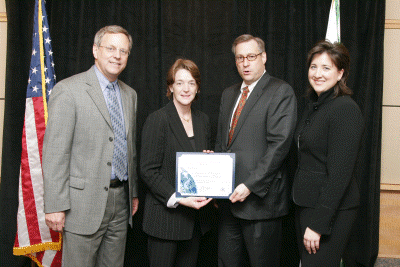
Arkema Climate Protection Team As a major energy consumer, Arkema is continuously improving the energy efficiency of its installations. Since 1990, the baseline year for the Kyoto Protocol, Arkema cut greenhouse gas emissions by two-thirds. Arkema also advocates that HFCs be used only where they offer environmental and technical advantages and that emissions be minimized. HFCs are powerful greenhouse gases that have hundreds to thousands of times the warming impact of carbon dioxide. Arkema has proposed that manufacturing associations worldwide use strict codes of practice to limit HFC emissions during manufacturing, and has already implemented these actions in its own facilities. In addition, Arkema is helping its customers reduce greenhouse gas emissions with patented Transcend© additive technology that improves foam performance while reducing the amount of HFC-245fa used in foam by up to 25%. Arkema's emissions reductions have been verified by independent, third party auditors, and detailed GHG emissions information is reported annually in their corporate sustainability report.
Climate Protection Campaign CPC also succeeded in persuading all nine of Sonoma County's mayors to sign on to the U.S. Mayors' Climate Protection Agreement led by Seattle's mayor Greg Nickels. All of the mayors also sent support letters for California bill AB32, a proposal that required a 25 percent cut in carbon dioxide pollution produced within the state's borders by 2020 in order to bring the total down to 1990 levels. CPC was able to round up several prominent businesses and about 1000 citizen signatures in support of the bill as well. The bill passed California's congress and was signed into law by Gov. Schwarzenegger in September 2006. In business initiatives, CPC helped Sonoma Wine Company reduce their greenhouse gas emissions by 43 percent while nearly doubling their production. Sonoma Wine is the organization's first partner in their Cool Business Alliance, a unique program partnership with state-funded energy efficiency programs. This partnership allows the CPC to engage local business partners with California's aggressive energy efficiency improvement goals. CPC also recruited Sonoma Wine Company and North Bay Construction to the EPA Climate Leaders program. CPC also helps local schools reduce their emissions. In a high school pilot program initiative, CPC worked with the student body to reduce their GHG emissions from commutes by 21 percent in only three weeks.
Improved Mobile Air Conditioning
Servicing Emissions Reduction Team Over the last two years, this servicing team has achieved extraordinary success. Central to their achievements is the new standard (SAE J-2788) published by the Society of Automotive Engineers for refrigerant recovery/recharge equipment. This new standard guarantees refrigerant recovery rates of 90% or better, and will result in a huge reduction in emissions over the coming years. Frank Rogers of GM, made a significant contribution to the standard by doing all of the "service lab" work to determine what could be achieved through more efficient recovery. Gary Murray of Robinair provided the sophisticated measuring scales for the investigative work and alternative equipment approaches to achieve the best results. Paul Weissler, an independent automotive technical writer with over 40 years of experience, promoted and encouraged the team's work, and translated the technical findings into a written test procedure. The Mobile Air Conditioning Service Emissions Reduction Team also developed new test standards that improve electronic leak detectors in two ways. First, the new test certifies detectors to identify chemicals in the refrigerant that would otherwise damage recovery/recycle equipment or contaminate already recovered refrigerant. Second, the new test certifies that leak detectors can pinpoint much smaller leaks, reducing emissions and increasing the reliability of repair. Bill Jamo chaired this segment' efforts, fought vigorously for a much more demanding standard with real-world testing and performance criteria, conducted testing of detectors, and helped write the final standard.
Joint Strike Fighter Emissions Test
Development Team The JSF Test and Data Quality Assurance Team includes Steven Hartle (Naval Air Systems Command), Robert Howard (Arnold Engineering Development Center), Curtis Kimbel (Naval Air Systems Command), John Kinsey (US Environmental Protection Agency), Richard Miake-Lye (Aerodyne Research), Wayne Miller (University of California-Riverside), Chowen Wey (NASA), and Phillip Whitefield (University of Missouri at Rolla). The Test Development Team combined their resources, skills and expertise to develop a new test methodology to quickly, accurately and economically measure particulate matter (PM) emissions from aircraft gas turbine engines. Aircraft engines emit aerosol particles and gaseous aerosol precursors into the upper troposphere and lower stratosphere during cruise operations. Altitude emissions may affect atmospheric chemistry and climate, and particle emissions at altitude are of especial concern because they create surfaces where ice can more easily form in aircraft condensation trails (contrails). EPA will accept the experimental test results as satisfying Joint Strike Fighter emission validation requirements if EPA confirms the scientific validity of the test and data. The new test protocol will characterize Joint Strike Fighter emissions using state-of-the-science particulate emissions testing instrumentation and will serve as a test bed to advance the scientific basis of environmental decision-making. It replaces "EPA Test Method 5" which does not measure the critical environmental criteria including particulate size, distribution, and chemical species. The new test methodology is a result of several years of testing of both commercial and military gas turbine engines and enables the DOD and commercial aircraft engine manufactures to gather much more accurate data than was previously possible. It also significantly reduces engine run times, lowering greenhouse gas and criteria air pollutant emissions and cutting the overall cost of engine testing by over $1,000,000 per aircraft engine tested.
Natural Resources Council of Maine Since NRCM's goal for this project is not only to educate but, ultimately, climate protection, they combined their message with their Maine Global Warming Challenge. The Challenge asks people to save at least 1,500 pollution pounds and help NRCM reach a goal to reduce 600,000 pounds of global warming pollution by Earth Day 2007. The project was launched on Earth Day 2006. By November 2006, they were already 82 percent toward reaching their goal, and decided to increase the reduction target. The success of their project demonstrates that reducing global warming pollution can be easy and also good for the family budget. Their sea-level rise report and their Maine Global Warming Challenge are excellent models that can be easily reproduced in other states. NRCM also worked on initiatives including Cleaner Car Sales Goals and global warming tailpipe emissions standards. NRCM was in favor of the Mars Hill wind farm that is now in operation, producing 42 megawatts of clean, renewable energy and providing economic benefit to the local community. NRCM's publication, Global Warming in Maine: Warning Signs, Winning Solutions, has already been reproduced in three other states. NRCM has also played a leadership role in developing RGGI to help reduce global warming pollution, save families and businesses money on electric bills, and generate an "energy fund" to encourage investment in energy efficiency.
Reverend Sally Bingham
Robert Parkhurst Robert was responsible for HP joining the World Economic Forum's Global Greenhouse Gas Registry, the California Climate Action Registry, and Sustainable Silicon Valley. Sustainable Silicon Valley is a collaboration of businesses, governments, and non-governmental organizations that work cooperatively to resolve environmental and resource pressures. As a founding member, Robert helped set the goal to reduce regional carbon dioxide (CO2) emissions 20% below 1990 levels by 2010 and he developed the protocols to measure progress. Robert has represented the Silicon Valley in numerous state and national forums. He has routinely spoken before the California Energy Commission, CalEPA, and Air Resources Board on what Silicon Valley companies are doing to reduce their climate impact. He was on the California Energy Commission's Climate Change Advisory Committee where he led the Industrial and Agricultural Committee. Most recently on the Board of Directors of the California Climate Action Registry, Robert has worked with the Board on strategies to leverage the experience of the Registry with other states and regions and work towards becoming a national-based registry. Robert is a leader in engaging California businesses in what they can do to respond to climate change. Through his efforts, the Silicon Valley Leadership Group was one of the only business groups to support AB32, the California Global Warming Solutions Act of 2006. Robert's leadership within HP, Silicon Valley, and the state of California has demonstrated that businesses can reduce their greenhouse gas emissions while growing their business.
Robert Redford Robert Redford's efforts span the globe, as evidenced by his 1989 Greenhouse Glasnost summit on climate change which he co-hosted at Sundance with the Soviet Academy of Sciences, More recently, he has focused attention on recruiting local government to take the fight against global warming to their cities through the Sundance Summits. He was among the first to surmise that citizens working at the community level will can take significant steps to reduce greenhouse gas emissions. In 2005 and 2006, Redford worked with the International Council for Local Environmental Initiatives (ICLEI) and Salt Lake City Utah Mayor Rocky Anderson to bring mayors from around the country together at the 'Sundance Summit: A Mayors Gathering on Climate Protection.' Mayors at the summit talked directly about the devastating effects of global climate change and investigated actions they and their communities can take to make a difference The inaugural event in 2005 reminded the 45 participating mayors (representing 28 states and 10 million U.S. citizens) of their power and their responsibility to protect the planet. They left Sundance with the knowledge and the tools to reduce greenhouse gas emissions in their cities. With the Sundance Summit, Redford successfully introduced local leaders to tools and expertise on climate protection to help mitigate global warming, one of the greatest threats to the health and prosperity of communities today. At the Summit's conclusion, the mayors of cities representing more than 10 million U.S. citizens agreed to work to reduce greenhouse gas emissions and endorsed the Summit as an annual event to support their climate protection efforts.
Auden Schendler Named a "Climate Crusader" in TIME magazine's 2006 special issue on Climate Change, Auden has been profiled in Outside, Fast Company, and Travel and Leisure magazine, and Aspen Skiing Company's environmental work has been featured on Nightline, the Discovery Channel, and in Newsweek, among other media outlets. Auden has spoken internationally on green business, and his writing on sustainable business, life in the West, kayaking and mountaineering have been published in journals ranging from Harvard Business Review to the L.A. Times. Aspen Skiing Company (ASC), has been recognized by the state of Colorado's Environmental Leadership Program as a "Gold Leader" and by the EPA as a National Performance Track member. ASC is ISO 14001 certified as a "green" company, the first of only two ski resorts in the country to achieve this recognition. ASC was the first ski resort to purchase any amount of wind power, and in 2006, ASC made a landmark purchase of renewable energy certificates from wind farms to account for 100 percent of its electricity use, the first major ski resort to do this. More than 50 resorts now buy some amount of wind power. Under Schendler's guidance, ASC implemented guidelines that call for all new construction to meet strict green standards. In fact, ASC built one of the first 10 U.S. Green Building Council LEED certified buildings in the US and certified the Snowmass Golf Clubhouse at the LEED Silver Level. That building is heated and cooled using the pond on the 18th hole. Aspen has an on-slope microhydroelectric plant, which uses spring snowmelt to generate clean power, and an employee foundation that in nine years has donated over $1 million to environmental projects. The snowcats at all four ASC mountains run on biodiesel, another industry first.
Ron Sims
Dadi Zhou |


